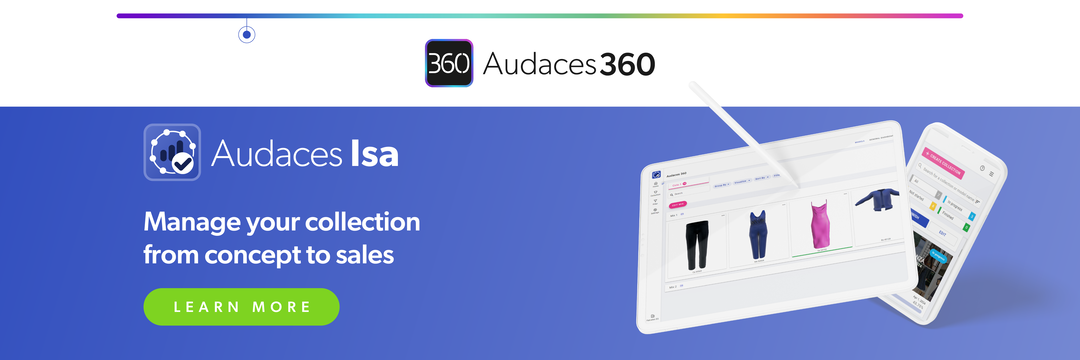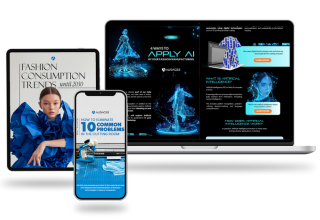Summary
- Digital trends are shaping how designers create, share, and sell their work. Being attentive to changes is key, as everything moves so fast.
- To stay ahead, professionals must speak the language of this new era. It’s about making sure you stay updated and achieve your maximum potential.
- Experience the future of the fashion industry with Audaces360. Start your free trial now!
From online sales to virtual fashion, new terms are everywhere. Understanding them isn’t just useful—it’s essential. They help you explore new opportunities and keep up with industry shifts.
Whether you work with digital tools, sell online, or just want to stay informed, this list will help. No complex jargon, just the must-know words and what they mean to you.
Ready to dive in? Keep reading and explore the digital side of fashion.
Enjoy your reading!
Sumário
Why should you know the different digital fashion terms?
Knowing digital fashion terms is more than just staying updated. It helps you understand new tools, trends, and ways of working. As fashion moves into the digital space, speaking the right language makes everything easier.
These terms shape how designers, pattern makers, and manufacturers communicate. Clear communication means fewer mistakes and faster production. When everyone knows the same terms, teamwork improves.
Many digital terms relate to technology that speeds up fashion creation. From 3D design to virtual fitting, these tools save time and reduce waste. They also help brands test ideas before producing physical garments.
When we talk about communication, it’s clear that e-commerce and social media have also transformed fashion sales. Understanding digital terms makes it easier to market designs, reach customers, and stay competitive.
Today, fashion isn’t just about the runway—it’s also about the online world. Therefore, learning the expressions that refer to clothing in the digital space is an investment in your future. It keeps you connected to the industry and opens doors to new opportunities.
The more you know, the more confident and creative you can be.
Learn more: How does digital fashion design work and what are the benefits for the clothing industry?
12 digital fashion terms worth knowing
Fashion and tech are tighter than ever. To keep you in the know, we’ve picked key terms that will help you understand how the industry is changing.
1) Fashion NFT
A Fashion NFT is a digital fashion item stored on the blockchain. It proves ownership and uniqueness, just like a physical designer piece.
Many brands create NFTs as collectibles or exclusive digital outfits. Some are linked to real-world benefits, like access to events or limited-edition clothing. Even haute couture brands are exploring this space, offering digital versions of their luxury designs.
Unlike traditional fashion, NFTs don’t age or wear out. They exist in virtual spaces, from social media to the metaverse. Some people buy them to wear in digital worlds, while others see them as investments.
For designers, NFTs open new creative possibilities. You can sell unique designs without producing physical garments, reducing waste and costs. A piece of clothing can now exist only in the digital realm, challenging the way we think about fashion.
Learn more: Learn how to drive business growth in fashion with NFTs
2) Phygital fashion
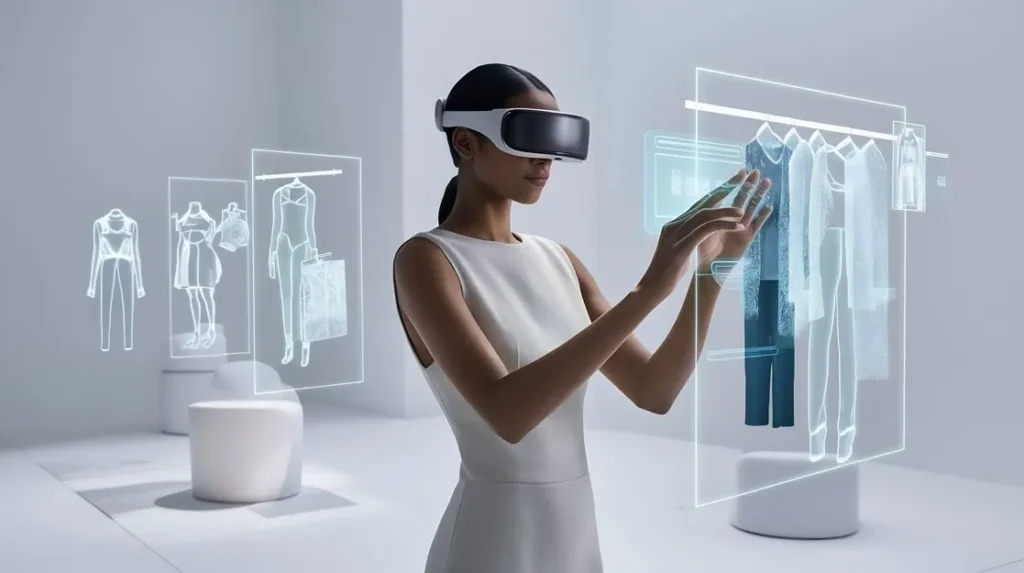
Phygital fashion combines physical and digital clothing. This trend is growing in gaming, social media, and the metaverse. People want to dress their digital avatars like they do in real life.
The digital item is not just a copy of the physical version—it can have unique features. A virtual dress, for example, might glow, change color, or move in ways a real garment similar to it never could.
Learn more: What is phygital fashion and how to integrate the physical and digital in apparel
3) Wearable technology
Wearable technology is clothing or accessories with built-in tech. It goes beyond style, adding smart features to everyday fashion.
Some items track fitness, like smartwatches or sensor-filled shoes. Others adjust to the environment, like jackets that warm up in cold weather. High-tech fabrics can even react to movement or light.
Brands focus on comfort and function. These pieces must fit the body naturally while hiding their advanced features. Designers are working on making smart fashion stylish and practical.
Wearable tech is also becoming more inclusive. With sensors and AI, clothes can adapt to different shapes and sizes, making fashion more accessible.
4) IoT in apparel manufacturing
The Internet of Things (IoT) is transforming clothing production. Smart devices connect machines, workers, and data to improve efficiency.
Factories use IoT to track materials, monitor production, and reduce waste. Sensors in machines detect problems before they cause delays. This keeps production fast and cost-effective.
For brands, IoT means better quality control. Real-time data helps ensure every piece meets high standards. Manufacturers can also adjust production based on demand, avoiding overproduction.
IoT is also improving sustainability. By tracking fabric use and energy consumption, companies can reduce waste.
Learn more: Find out how fast fashion and sustainability can coexist in the apparel industry
This step-by-step guide will show you how to seamlessly integrate technology into your fashion business. Plus, it’s totally free. Download it now!
5) Big Data in fashion
Big Data helps fashion brands understand trends and customer behavior. It analyzes huge amounts of information to make better decisions.
Retailers use it to predict what styles will be popular. They track online searches, social media trends, and past sales to plan future collections. This reduces the risk of making clothes no one buys.
Big Data also improves personalization. Online stores recommend items based on what customers like, creating a customized shopping experience.
6) Omnichannel experience
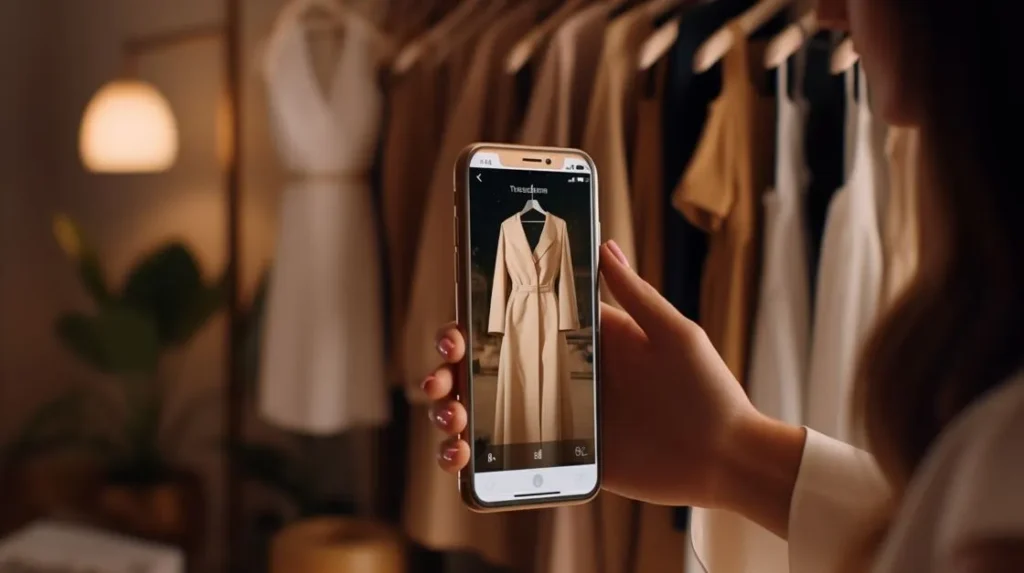
An omnichannel experience connects online and offline shopping. It gives customers a smooth journey across different platforms.
For example, someone might browse a product on their phone, try it in-store, and buy it later on a laptop. The omnichannel experience is seamless, with the same prices, options, and support everywhere.
Many brands use social media, apps, and websites to engage customers. Live shopping events, virtual fitting rooms, and AI chatbots make online shopping more interactive.
Even ready-to-wear brands are increasingly adopting this approach. They make sure customers can buy their products easily, no matter how they shop. The goal is convenience and connection across all channels.
7) Algorithmic design
Algorithmic design uses computer programs to create fashion. Designers set rules, and the software generates patterns, shapes, or textures.
This method speeds up the creative process. It can suggest unique designs based on trends, body shapes, or material constraints. Some brands use it to make custom clothing for individual customers.
Many luxury and sportswear brands are experimenting with this technology. As AI improves, designers will have even more powerful tools to create innovative styles.
8) Digital Asset Management (DAM)
Digital Asset Management (DAM) helps fashion brands organize digital files. It stores images, videos, design sketches, and marketing materials in one place.
With DAM, teams can easily find and share content. This improves collaboration between designers, marketers, and manufacturers. It also ensures brand consistency across different platforms.
For global fashion companies, DAM is essential. It allows teams in different locations to access the same assets instantly. This speeds up production and marketing.
9) Texture mapping
Texture mapping is a digital technique that adds realistic surfaces to 3D clothing models. It makes fabrics look detailed and lifelike in digital fashion design.
Designers use texture mapping to create patterns, wrinkles, and shine on virtual garments. This helps them visualize the final product before making real samples.
E-commerce and gaming also benefit from this technology. Online shoppers can see how fabrics look and move before buying. Video games and virtual worlds use it to create realistic outfits.
Different types of clothing require different textures. A wool sweater needs a soft, fuzzy effect, while leather needs a glossy surface. Texture mapping ensures these details appear correctly.
Learn more: Everything you need to know about clothing texture mapping
10) Virtual Reality (VR) in fashion
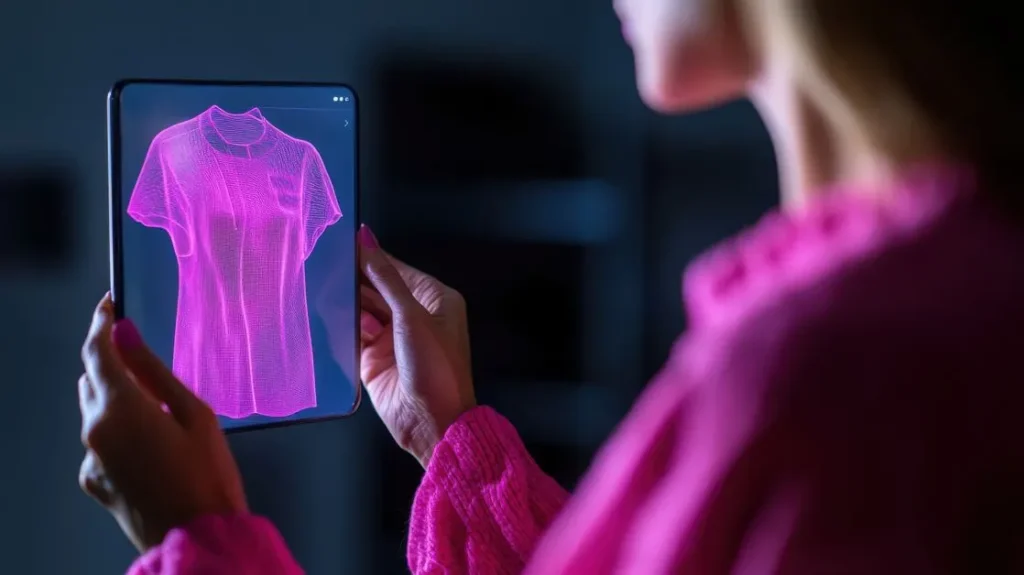
Virtual Reality (VR) is changing the way people experience fashion. It allows users to explore digital stores, attend fashion shows, and try on clothes in a virtual space.
Brands use VR to create immersive shopping experiences. Customers can walk through a digital boutique and see products in 3D before buying.
Fashion designers also use VR for prototyping. They can adjust styles, colors, and fits without making physical samples. This saves time and materials.
Even designer clothing brands are adopting VR. They create exclusive virtual events and showrooms for customers, making fashion more interactive.
Learn more: Discover all about the intersection of fashion and virtual reality
11) Supply chain digitalization
Supply chain digitalization makes fashion production faster and more efficient. It connects factories, suppliers, and brands through digital tools.
With real-time tracking, brands can see where their materials and products are at any moment. It reduces delays and improves inventory management.
Automation and AI also help. Machines can predict demand, optimize shipments, and reduce waste. This lowers costs and makes production more sustainable.
Fashion companies that digitalize their supply chains can react quickly to market trends. They produce only what is necessary, avoiding overproduction and excess stock.
Learn more: How to overcome the challenges in the textile industry’s supply chain
12) Gamification
Gamification uses game-like elements in fashion to engage customers. Brands add rewards, challenges, and interactive experiences to make shopping more fun.
Some companies offer points for purchases, social media shares, or virtual try-ons. Others create online games where users can design outfits and unlock special discounts.
It can also help in fashion education. Digital platforms teach designers and consumers about materials, sustainability, and styling through interactive lessons.
How do fashion terms influence communication between designers, pattern makers, and manufacturers?
Fashion terms create a common language in the industry. These professionals need clear communication to bring ideas to life, and using the right terms avoids confusion.
Precise language helps with technical details. A designer might request a specific type of seam to achieve a certain look. If the pattern maker and manufacturer understand the term, they can follow the instructions correctly.
Fashion terms also ensure consistency in production. Standard sizes must be followed to create garments that fit properly. When everyone uses the same measurements and terminology, the final product matches the original design.
Global and digital teams rely on fashion terms even more, as many companies work with manufacturers in different countries.
Clear, industry-standard vocabulary makes it easier to collaborate across languages and cultures.
Create digital fashion seamlessly with Audaces360
Audaces360 integrates cutting-edge digital innovations to optimize workflows in the textile and apparel industry.
It caters to companies of all sizes and types, offering the flexibility to scale with your business needs.
All solutions were carefully developed to address the specific challenges of the field. They streamline the design and production processes, saving valuable time and resources.
The platform boasts a comprehensive range of functionalities, including pattern making, marking, collection management, vector drawing, and 3D creation.
In addition, a fashion Artificial Intelligence to assist you along the way.
FAQ
Knowing digital fashion terms is more than just staying updated. It helps you understand new tools, trends, and ways of working. As fashion moves into the digital space, speaking the right language makes everything easier.
Fashion NFT, phygital fashion, big data in fashion, omnichannel experience, and gamification.
Fashion terms create a common language in the industry. These professionals need clear communication to bring ideas to life, and using the right terms avoids confusion.


